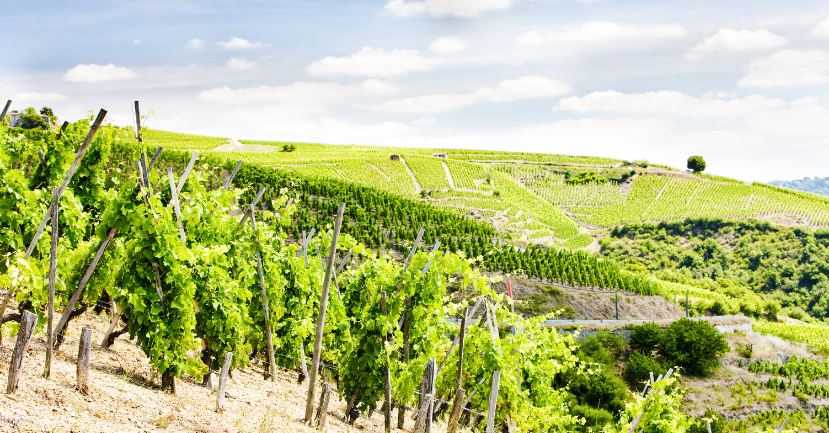BLOG
25 French Wine Terms You Need To Know
Lisa Airey
Wine Education & Careers

One could argue that France is the philosophical heart of fine wine. Much of what the world now does, from vineyard practices to winemaking techniques, can be traced back to the viticultural motherland. Here are some must-know terms for exploring the wines of France.
1. AOC
Shorthand for Appellation d’Origine Contrôlée, this represents a guarantee of origin and, subsequently, certain attributes with regard to the style and quality of a given wine. Established in 1935, this French system of delineating zones of production and setting production standards has been emulated across Europe.
2. Assemblage
This is the art of blending various lots of wine together to create a final product. In Champagne, for example, a house may have dozens of still base wines from which to choose when “assembling” their cuvée—a blend which then undergoes a second fermentation in the same bottle from which it is later served.
3. Barrique
The barrique is a unit of measurement. The generic term for a wooden holding vessel is “cask.” The barrique, common to Bordeaux, holds 225 liters or 25 cases of wine.
4. Blanc de Blancs
This style of wine is commonly found in sparkling wine production and denotes a white sparkling wine made exclusively from white grapes.
5. Blanc de Noirs
Another common term found on bottles of sparkling wine, this product is a white sparkling wine made exclusively from red grapes.
6. Cépage
A French term meaning “grape variety.”
7. Chevillé
The pressure inside a bottle of champagne modifies the shape of its cork closure over time. After many years in the bottle, the integrity of the cork declines, allowing effervescence to escape. Upon opening, the cork will appear “peg-shaped” or “chevillé.”
8. Climat (vs. Lieu-Dit)
A lieu-dit is a named parcel of land that is registered at the town hall as a technical cadastral unit (for taxation purposes). A climat is more of a grape-grower’s notion of a particular parcel with certain attributes. Climat finds its origin in the Greek “klima” meaning “incline” which conveys the notion of exposure to the sun. The two are not mutually exclusive. A climat can be comprised of several lieux-dits; a single lieu-dit can also be a recognized climat. The term “climat” is largely reserved to parcels ranked as Premier or Grand Cru in Bourgogne—the best and most favorably situated vineyard parcels.
9. Clos
A plot of vines traditionally surrounded by stone walls. Famous clos include Clos de Tart in Bourgogne, Clos Sainte-Hune in Alsace and Clos du Mesnil in Champagne.
10. Côte
This term translates to “hill” or “slope” and given the merits of hillside viticulture, it is found in its many forms (côte, côtes, coteaux) throughout France, from the Côte d’Or to the Côtes de Bordeaux and beyond.

11. Crémant
Adopted in the 1980s, this term is used to denote French sparkling wines made according to the traditional method outside of Champagne
12. Cru
Literally translated as “growth,” its use throughout France always denotes quality, albeit with different parameters. In Burgundy, the top vineyard sites are classified as Premier Cru and Grand Cru. In Bordeaux, the top châteaux are ranked from Premier Grand Cru Classé (First Growth) through Cinquièmes Grand Cru Classé (Fifth Growth). In the northern and southern Rhône, entire appellations are ranked as cru or non-cru.
13. Cuvée
Cuvée has several definitions. The term can describe a special parcel or batch of wine or a blend.
14. Élevage
Literally translated as “breeding” or “rearing”, it refers to the process of aging a wine before bottling.
15. Juponé
After only a few years in bottle, a champagne cork will expand when opened, giving it a mushroom-like shape known as “juponé.”
16. Monopole
This term refers to a plot of land with a single owner.
17. Mousse
This fancy term refers to the foam or sparkle of a Champagne or other sparkling wine. As most champagne is bottled between five and six atmospheres of pressure, it has a soft mousse defined by tiny bubbles. Sparkling wines bottled at lower pressure, or made in other fashions, will have larger bubbles and thus a more aggressive mousse.
18. Nouveau
Nouveau wines (also known as Primeur wines) are fresh and fruity bottlings meant for immediate consumption. They are released just months after harvest. This style of wine was popularized by Beaujolais and is enjoyed around the world.
19. Pourriture Noble
Otherwise known as Noble Rot, this important and beneficial fungus is responsible for the legendary sweet wines of France, most notably Sauternes. Aided by misty mornings and sunny afternoons, the botrytis cinera fungus penetrates the skin of the berry, reducing water content and concentrating sugars, acid and flavor.
20. Saignée
Saignée is a common rosé production technique. It involves “bleeding” the tank of pigmented juice in order to increase the juice-to-skin ratio in the resulting vat of wine. The goal of saignée is to make a better red wine. Two wine products are made from this vat of macerating juice: rosé and a (much more concentrated) red wine.
21. Sélection de Grains Nobles
Often shortened to SGN, Sélection de Grains Nobles represent a sweet wine made from botrytized grapes. Although most often associated with the sweet wines of Alsace, this term is also found in the Loire Valley.
22. Supérieur
This term signifies that the wine in the bottle achieved a higher alcohol content than the appellation minimum, usually by half a degree. It does not necessarily denote superior quality.
23. Sur Lie
Sur Lie aging is the important process of allowing a wine to sit in contact with its lees, or dead yeast cells. Many of France’s famous wine regions are defined by this technique, most notably Champagne and Muscadet Sevre-et-Maine.
24. Terroir
The quintessential French wine term! While there is no official definition, famed wine writer Matt Kramer once described terroir as a wine’s “somewhereness.” A wine’s terroir encompasses the geology, soil, climate, aspect, elevation and topography as well as the hand of man.
25. Vieilles Vignes
Vieilles Vignes denotes a wine made from old vines. Interestingly, the term is not legally defined. Some growers label their wines “vieilles vignes” when the vines are 35 years of age, while others consider the term appropriate for those vines only well over 50. Vines can live to be over 100 years old!




